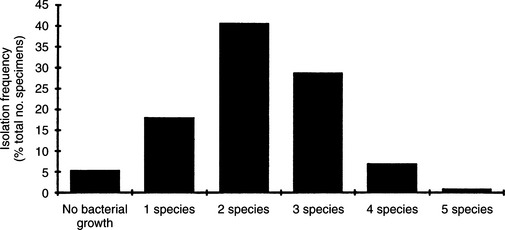Chapter 24 INFERTILITY, ASSOCIATED BREEDING DISORDERS, AND DISORDERS OF SEXUAL DEVELOPMENT
DEVELOPING THE PROBLEM LIST
Assessment of the Male
All active stud dogs should be tested for brucellosis every 6 months. Less active studs should be checked yearly and immediately prior to use. A male that has not sired a litter or that has sired litters in the past but not in the preceding 6 to 12 months must be viewed with suspicion. Whenever the male’s fertility is questionable, the owner of the bitch has three main alternatives: (1) have a semen analysis and Brucella titer performed on the male; (2) use an alternative, proven sire on the next heat; or (3) have the bitch evaluated, realizing that she may not be at fault.
History (Anamnesis)
OBTAINING A “COMPLETE” HISTORY.
To avoid the time-consuming chore of asking all the questions that help establish a problem list, differential diagnosis, and diagnostic plan, the veterinarian should have clients complete a questionnaire (Table 24-1). This list does not necessarily provide a complete background on every bitch, nor does it always provide the information needed to determine a diagnosis, but it does include the basic questions that must be answered to establish a foundation from which to work. Also, items can always be forgotten when reviewing a case history during a busy workday, and the question sheet helps avoid this problem.
TABLE 24-1 CLIENT QUESTIONNAIRE–THE INFERTILE BITCH
AGE AND BREED.
Small dogs reach sexual maturity at a younger age than large dogs. The onset of the pubertal (first) estrus in the bitch has been reported to occur at ages ranging from 6 to 23 months, with mean ages in different study populations of 9.6 to 13.9 months (Wildt et al, 1981; Johnston, 1991). Virtually all healthy bitches, therefore, begin ovarian cycles by 24 to 30 months of age.
Because first and second cycles may be irregular, unusual, short, or long (Wright and Watts, 1998), infertility evaluations are delayed in most dogs until 24 to 30 months of age. Just knowing the age and breed, therefore, can help the clinician decide how aggressive to be diagnostically. Toy Poodles may benefit from evaluation earlier in life than Bull Mastiffs. Each breed does have distinct average interestrous intervals, but the interval varies within a breed. As a general rule, almost all breeds cycle once every 4.5 to 10 months. The African breeds cycle once yearly. The remainder of the critical factors in an infertility evaluation are described under each major subheading.
Physical Examination
DIGITAL EXAMINATION OF THE VESTIBULE AND VAGINA.
A digital examination of the vaginal vault should be performed routinely on any bitch examined for breeding soundness. If a culture or cytology specimen is needed, it should be obtained prior to the digital examination. Most bitches are easy to examine. A gloved, lubricated index finger should pass easily into the vaginal vault, allowing assessment of the lumen, the urethral opening, and the size and shape of the clitoris. Masses, foreign bodies, strictures, painful vaginitis, or abnormal tissue bands all prevent easy and painless examination.
If the digital examination result is abnormal but inconclusive, vaginoscopy can be performed for a more thorough evaluation. An otoscope or a vaginal speculum provides an extremely limited view of the vaginal vault and is of little value in most clinical situations. Pediatric proctoscopes are easy to use for vaginoscopy (Fig. 24-1), are relatively inexpensive, and can be used in all but the smallest of miniature breeds. An endoscope is a more expensive but smaller diameter alternative. In most breeds a small-diameter pediatric proctoscope can be used, which provides far better visualization of the area than an otoscope. If vaginoscopy is performed, the clinician must be knowledgeable about the changes in the appearance of the vaginal mucosa associated with each phase of the estrous cycle (Table 24-2).
TABLE 24-2 CHANGES SEEN IN THE VAGINAL MUCOSA DURING THE ESTROUS CYCLE
RECTAL EXAMINATION.
A rectal examination ensures that the pelvic canal has been assessed for previous fractures or other unsuspected abnormalities. Compression of the pelvic canal is a potential cause of dystocia and, less commonly, inability to breed. An attempt can be made to palpate the vagina ventrally, although this organ would have to be extremely abnormal to reveal anything suspicious on palpation.
Owner Management Practices
COMMON MISTAKES.
General Health of the Bitch
In the clinical evaluation of the infertile bitch, one underlying question is her overall health status. Some investigators have recommended complete blood counts, chemistry panels, urinalysis, and thyroid and adrenocortical function studies as initial steps in the evaluation of a potentially infertile bitch (Johnston, 1980; Johnston et al, 1982; Lein, 1983). Others have suggested that, “It is unethical and unprofessional to perform unnecessary tests without discussion with the owners as to the real value and cost of these investigations” (Wright and Watts, 1998).
INFERTILITY IN THE BRUCELLA-NEGATIVE BITCH THAT HAS NORMAL OVARIAN CYCLES, NORMAL INTERESTROUS INTERVALS, AND THAT ALLOWS BREEDING (Fig. 24-2
Initial Approach
BEHAVIOR OBSERVATION
Predetermined Dates.
If a bitch is in proestrus for 16 days and estrus for 10 days, ovulation is likely to begin on day 19 or 20 and fertilization on days 22 through 26. If she was bred (artificially inseminated because natural breeding would not have been allowed by the bitch) on days 10 and 12, few if any sperm would be alive when fertilization takes place (see Fig. 24-6). Forced mating or artificial insemination or both may be performed in an attempt to ensure that breeding occurs on the predetermined dates, only to have the bitch later appear infertile, with no consideration given to the fact that she was bred on the wrong dates. Forced breeding is never acceptable and should be a clue that errors in management are likely.
Male Preference.
Some bitches refuse a particular male or, less commonly, refuse mounting attempts by any male despite correct recognition of estrus. Preferences for particular mates have been documented in the bitch (Freshman, 1991). Three possible explanations for this frustrating dilemma are (1) the male has been brought to the bitch for mating, and she is dominant to him when she is at her home (the bitch does not allow submissive males to breed); (2) the male is submissive to the bitch in standing heat, regardless of the environment and regardless of the apparent relationship between these dogs at other times (Freshman, 1991); and (3) the bitch is housed with a bitch dominant to her and the other female may interfere with normal breeding behavior.
OVARIAN FUNCTION IN PROESTRUS AND ESTRUS.
Vaginal Cytology.
Like behavior, follicular function can be easily and inexpensively monitored. The owner should be taught how to obtain vaginal smears and then instructed to begin obtaining smears on the first day of proestrus, continuing daily until at least 4 to 5 days after the onset of behavioral or cytologic diestrus. Vaginal cytology is a reflection of peripheral estrogen concentrations, which in turn reflect follicular function. Vaginal smears identify the approximate days of estrus and can be used to definitively identify the beginning of diestrus (Olson et al, 1984). One can count back 6 days from day 1 of diestrus to the first likely day of ovulation and/or count back 1 through 4 days for the time of greatest fertility (see Chapter 19). Recognizing that viable sperm can survive approximately 4 to 7 days in the uterus after breeding, the veterinarian can determine if the breeding dates were optimal for fertilization. If not, the bitch should be managed differently to better coordinate breeding with fertilization. If the breeding dates were optimal, management problems can be excluded from the list of causes of infertility.
Plasma Progesterone.
The results of vaginal cytology can be reliable and helpful. However, to enhance evaluations, serial serum progesterone concentrations should be determined as the bitch progresses through proestrus and into estrus (see Chapter 19). Frequent serial progesterone assessments allow identification of the first day that the concentration rises above 2 ng/ml, which should coincide closely with the onset of behavioral estrus and the luteinizing hormone (LH) surge (Hegstad and Johnston, 1992). If an enzyme-linked immunosorbent assay (ELISA) in-hospital kit is used for the tests, the progesterone concentration usually is estimated as less than 1 ng/ml, greater than 1 to less than 5 ng/ml, and greater than 5 ng/ml (Manothaiudom et al, 1995). Breeding is recommended 4 days after the serum progesterone concentration is greater than 1 ng/ml as measured with these kits. Optimal breeding dates are 4 and 6 days after the rise in the serum progesterone concentration. Vaginal endoscopic evaluation of the bitch several times during proestrus and into estrus can also be informative (see Chapter 19 and 20) (Lindsay, 1990).
OVARIAN FUNCTION IN DIESTRUS: DETERMINING WHETHER OVULATION HAS OCCURRED.
The question regarding ovulation cannot be answered with testing completed during proestrus or estrus. Vaginal cytologic identification of the first diestrual day offers an indirect method of determining an approximate ovulation date, as previously described. However, a more precise determination can be made by measuring the plasma progesterone concentration daily or on alternate days. Ovulation begins 2 to 4 days after the progesterone concentration rises above 2.0 ng/ml (see Fig. 19-15). Again, these values do not confirm that ovulation took place, because progesterone is initially derived from luteinized follicles; that is, the serum progesterone concentration increases prior to actual ovulation. The initial rise does not confirm that ovulation occurs.
REVIEW OF SHIPPING PRACTICES: POSSIBLE STRESS.
Breeding practices need to be reviewed as potential problem areas. For example, it is not known whether tranquilization or the stress of shipping can interfere with ovulation or early pregnancy (Wright and Watts, 1998). These factors could be a cause of “acquired infertility” and are worth avoiding during one cycle to see if the infertility problem can be resolved by keeping the bitch at home and having her bred locally.
HYPOTHYROIDISM.
Most reviews concerning infertility in the bitch include discussion of hypothyroidism, a condition often described as common and as producing such signs as persistent anestrus, prolonged interestrous intervals, and prolonged proestrus, although some bitches demonstrate normal reproductive activity, pregnancy, and parturition (Johnston, 1980). However, only one bitch has been described in the veterinary literature since 1989 that had thyroid insufficiency and related ovarian disease (Johnston, 1989).
Hypothyroidism is an overdiagnosed endocrine disorder in veterinary practice. The diagnosis should always be viewed with suspicion, not because the disease does not exist but simply because many dogs treated for the disease are not so afflicted. If a bitch is being treated for hypothyroidism, the veterinarian must decide whether that diagnosis was correct and then whether thyroid replacement medication should be discontinued (see Chapter 3).
SUMMARY OF MANAGEMENT PROBLEMS.
Management problems are the most common cause of apparent infertility in the bitch with a normal cycle (Johnston, 1980; Soderberg, 1989; Freshman, 1991). Veterinarians should remember to evaluate the male before embarking on the somewhat involved task of assessing the bitch. The entire question regarding proper management of an individual bitch can be answered through the relatively inexpensive approach of obtaining a thorough history, with corrections made, as needed, in past incorrect practices; behavior observation; review of vaginal cytology results; and monitoring of plasma progesterone concentrations. This approach answers the following questions: (1) how is the owner managing this bitch? (2) when does standing heat begin? (3) how long does standing heat persist? (4) what is the first day of true diestrus? (5) when is the bitch truly fertile? (6) what are her ideal breeding dates? (7) does she ovulate? (8) when does she ovulate? and (9) does she have the luteal function necessary to support pregnancy?
Brucella Infection
Brucella canis classically causes abortion late in gestation (see Chapter 26). In addition, the organism may render a bitch infertile or may cause resorption of fetuses early in gestation. B. canis infection can also result in ill or stillborn puppies (Olson et al, 1983). All bitches in active breeding programs should be repeatedly evaluated for canine brucellosis. The rapid slide agglutination test (Canine Brucellosis Diagnostic Test; Pitman-Moore, Washington Crossing, NJ) is an excellent screening test. False-negative results are unlikely, and a negative result can be trusted. Bitches that test seropositive should be retested with the tube agglutination method, because false-positive results do occur (Johnston, 1980).
Problems Arising from Infection
QUESTIONABLE VALUE OF A POSITIVE RESULT ON VAGINAL CULTURE.
Culture Technique.
Bacterial infections have been implicated as a cause of infertility in the bitch (Johnston, 1980; Lein, 1983). These infections are thought to be subclinical in the infertile bitch, only occasionally resulting in obvious vaginitis, metritis, pyometra, or systemic infection. It has been recommended that the anterior vagina of infertile bitches be cultured with a guarded swab (Accu-CulShure, from Accu-Med, Pleasantville, NY; Guarded Culture Instrument, from Kalayjian Industries, Long Beach, CA; and Tiegland Swab, HL 206400, from Haver-Lockhart Laboratories, Shawnee Mission, KS). Bacterial isolation and identification, as well as antimicrobial sensitivity, are suggested, after which the bitch can be given the appropriate antibiotics for 4 weeks (Johnston, 1980). However, it is difficult to establish the role of bacterial infections in canine infertility. Virtually all normal bitches have bacterial flora in the anterior vagina, and similar types of aerobic bacteria are present in the vaginal vaults of infertile bitches (Olson et al, 1983; Okkens et al, 1992). For these reasons, a request by stud owners that a vaginal culture be free of bacteria prior to mating is nonsensical (Watts et al, 1996; Wright and Watts, 1998).
Bacteria.
Approximately 95% to 100% of normal bitches harbor aerobic bacteria in the vaginal tract (see Table 23-2; Bjurstrom and Linde-Forsberg, 1992a). A wide variety of bacteria have been isolated from normal canine vaginal tracts, and the numbers are often increased during proestrus and estrus. Merely isolating bacteria from the vagina does not constitute the basis for a diagnosis of disease; rather, it is likely to confirm that a bitch is normal. Furthermore, the most worrisome organism, B. canis, may be difficult to isolate. A negative culture result, therefore, does not ensure that a bitch is free of an infectious disease.
The types of bacteria may vary with the age of the bitch; a higher percentage of prepubertal bitches have coagulase-positive staphylococci than do postpubertal dogs. The stage of the cycle did not alter the types of bacteria isolated in some studies, but other studies demonstrated increased numbers in proestrus and estrus (Allen and Dagnall, 1982; Baba et al, 1983). In a more recent study, the bacteria isolated did vary with the stage of the ovarian cycle (Fig. 24-3) (Bjurstrom and Linde-Forsberg, 1992a). The composition of the gram-positive and gram-negative organisms has been found to be unique to individual dogs.
Normal flora usually are recovered in mixed cultures of light to moderate growth (see Table 23-2; Bjurstrom and Linde-Forsberg, 1992a). If an organism is a significant pathogen, it usually produces clinical signs, is recovered in large numbers, and is present in a nearly pure culture because it gains advantage as a pathogen and overgrows the normal mixed flora (Allen and Dagnall, 1982; Allen, 1986; Olson et al, 1986). Of 826 vaginal swabs taken from 59 healthy, fertile bitches, cultures of only one organism were identified in 18%; mixed cultures were seen in 77%; and completely negative results occurred in only 5% (Fig. 24-4) (Bjurstrom and Linde-Forsberg, 1992a).
Some owners of stud dogs require a “negative” vaginal culture from the bitch to be used in breeding. However, most male dogs harbor microorganisms in the prepuce and urethra similar to those identified as normal vaginal flora (Bjurstrom and Linde-Forsberg, 1992b). There is no justification for refusing to breed a bitch to a stud dog because bacteria have been isolated from the vagina.
It should now be clear that it is unjustified to associate positive findings on vaginal cultures with infertility. Systemic antibiotics may have significant side effects. Heavy growth of one bacteria is more likely to be normal than abnormal. Treatment with vaginal douches for 2 to 3 weeks, with or without systemic antibiotics, may be beneficial, but such therapies should be reserved for bitches with obvious clinical signs of infection, such as a purulent vaginal discharge (Bjurstrom and Linde-Forsberg, 1992a and 1992b).
Finally, the canine uterus may contain small numbers of bacteria and still be normal (Baba et al, 1983). Obtaining a uterine culture requires laparotomy or transcervical uterine cannulation during proestrus, estrus, or diestrus. However, in normal fertile bitches these phases of the estrous cycle are associated with migration of bacteria from the vaginal vault into the uterus via the relaxed cervix (Watts and Wright, 1995). Without obvious vaginitis or pyometra, vaginal cultures are not believed to be of benefit in managing the infertile bitch.
MYCOPLASMA AND UREAPLASMA INFECTIONS.
Mycoplasma and Ureaplasma are organisms commonly cultured from the vaginal tract of normal bitches. However, a syndrome of poor conception, early embryonic death, embryonal or fetal resorption, abortion, stillborn pups, weak newborns, and neonatal death has been suggested to be caused by these smallest of free-living microorganisms. Currently, evidence regarding the pathogenesis of these disorders is circumstantial (Doig et al, 1981; Lein, 1989). As with bacterial culture results, if large numbers of these organisms are identified in pure or nearly pure growth from the vaginal vault of a breeding bitch with an infertility problem, these microorganisms may be at fault. However, in one study 59% of healthy, fertile bitches had Mycoplasma organisms recovered from vaginal swabs (Bjurstrom and Linde-Forsberg, 1992a). Management includes isolation of the animal and tetracycline or chloramphenicol therapy for 10 to 14 days (Lein, 1986).
Chronic Endometritis: Cystic Endometrial Hyperplasia
BACKGROUND.
The bitch with chronic endometrial disease is likely to be infertile. These dogs could experience normal ovarian cycles, ovulate, and have fertilized eggs but fail to support pregnancy because of the abnormal uterine environment that prevents implantation or that would result in fetal resorption (Allen and Dagnall, 1982). After evaluating the male and the owner’s management practices, the clinician should be able to assess the likelihood of an ovarian problem. If the male is normal, ovarian function is normal, the bitch is free of brucellosis, and the timing of breeding is correct, an underlying endometrial problem is possible. CEH (sterile or infected) can be extremely difficult to confirm. The diagnosis is suspected if the nonpregnant uterus is thickened or abnormally large in anestrus or diestrus. Although a thickened uterine wall is a potentially palpable abnormality, it is difficult to be certain that one is palpating the uterus. Radiographically, the nonpregnant uterus is rarely visible. If the uterus is visible in a bitch with an infertility problem, endometrial disease is possible. Similarly, visualization of the nonpregnant uterus using abdominal ultrasonography may be a means of documenting the presence of a thickened endometrium or of intraluminal fluid. The diagnosis can be confirmed only by uterine biopsy.
TRANSCERVICAL UTERINE MICROBIOLOGY AND CYTOLOGY.
Procedures for transcervical cannulation of the uterus are now feasible with injection and aspiration of sterile fluid for culture and cytology (see Chapter 20). Cells identified in normal aspirates include endometrial cells, leukocytes, erythrocytes, cervical cells, bacteria, and sperm. Endometrial cells appear degenerative in diestrus and anestrus. Neutrophils are the most common white cells present during proestrus and estrus (Watts et al, 1997 and 1998). This procedure can aid in the recognition of CEH and other endometrial disease.
Early Fetal Resorption
Early fetal resorption usually appears to both owner and veterinarian as primary infertility because early pregnancy is so difficult to confirm. Pregnancy can-not be recognized by palpation until after 21 days of gestation, and then the diagnosis is subjective. Radiographically, pregnancy cannot be confirmed until 42 to 45 days of gestation. The earliest that pregnancy can confidently be identified is approximately 16 days after first breeding, using ultrasonography. This imaging technique has been help-ful in the detection of early fetal resorption. Early fetal resorption suggests an endometrial disorder (infection or CEH), failure of corpora lutea to support pregnancy (hypoluteoidism), infectious disease (e.g., brucellosis), fetal defects (e.g., chromosomal anomalies), or some less common disorder. However, early embryonic loss has not been well investigated, and in most cases the diagnosis is speculative. Only definitive diagnosis of pregnancy through ultrasonography with demonstration of fetal death and resorption is specific for recognition of this condition. With such a diagnosis, the management alternatives are to use a different male on the next cycle or to consider uterine culture and biopsy by means of surgery or transcervical cannulation (Wright and Watts, 1998).
Hypoluteoidism
If the progesterone concentration is below 1.0 ng/ml when a bitch is timed to be in diestrus, either she never ovulated or the corpora lutea have failed to synthesize and/or secrete progesterone. Serum progesterone concentrations above 5 ng/ml should be sufficient to maintain pregnancy. If the progesterone concentration is 1.0 to 5.0 ng/ml, the amount of progesterone secreted may be insufficient to maintain pregnancy (hypoluteoidism), and abortion or fetal resorption may result. If fetuses are observed on abdominal ultrasonography early in gestation, abortion or fetal resorption should become demonstrable with repeated ultrasound examinations. (See Chapter 21 for a complete discussion of hypoluteoidism.)
Stay updated, free articles. Join our Telegram channel

Full access? Get Clinical Tree



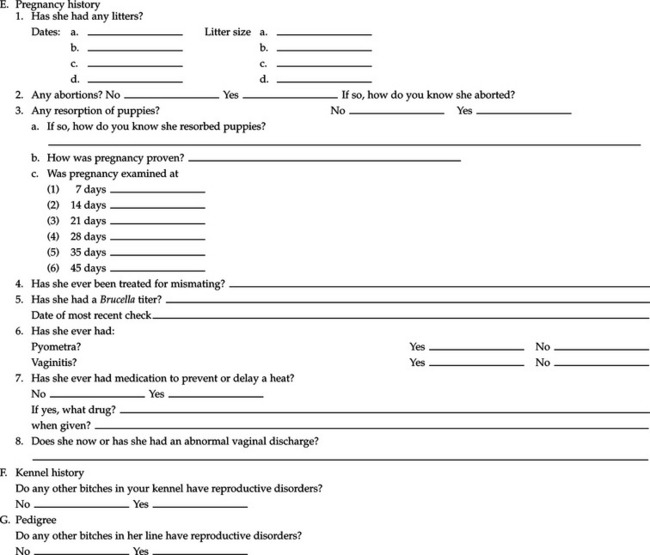
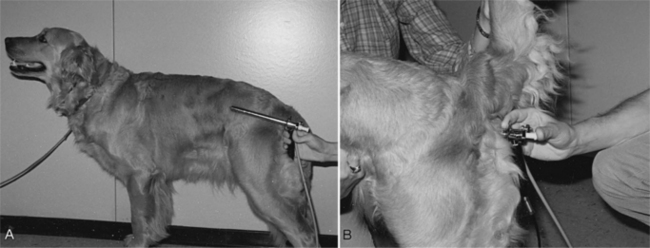
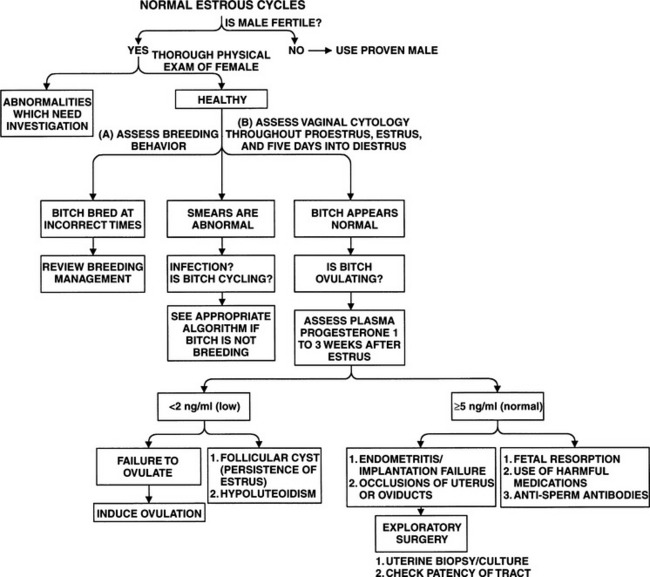
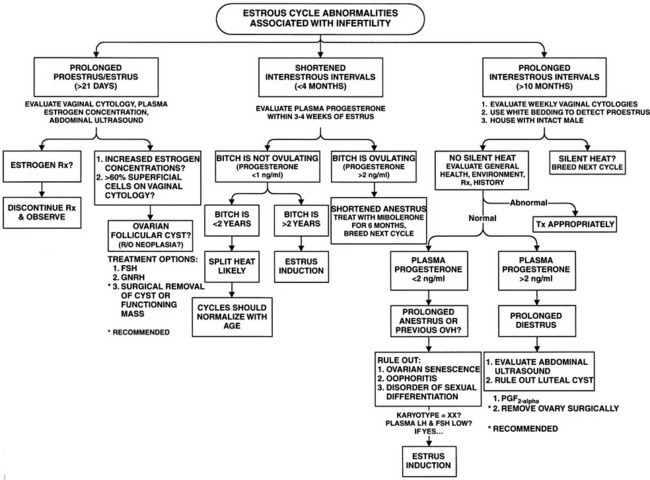
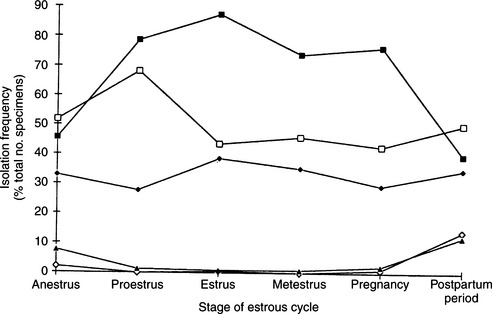
 ), Pasteurella multocida; (
), Pasteurella multocida; ( ), β-Hemolytic streptococci; (
), β-Hemolytic streptococci; ( ), Escherichia coli; (
), Escherichia coli; ( ), Staphylococcus intermedius; (
), Staphylococcus intermedius; ( ), Enterococci.
), Enterococci.